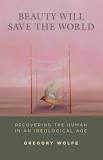Beauty Will Save The World:
Recovering the Human in an Ideological Age
Gregory Wolfe
–Review by Teri Hyrkas
It was the title of this book, Beauty Will Save the World (ISI Books, 2011), that caught my attention. Such a marvelous – and outlandish – statement! What did author Gregory Wolfe, editor of the respected Image Journal magazine, mean by it? As a Christian, the idea of saving the world has always been the exclusive domain of Jesus the Christ. Where on earth was Wolfe headed with his book on “saving the world?” And what did beauty have to do with it?
Wolfe tells us in his prologue that he came upon the phrase, “beauty will save the world,” in a translation of the lecture given by Aleksandr Solzhenitsyn when he was awarded the Nobel Prize for Literature. Solzhenitsyn took the phrase from Fyodor Dostoevsky’s novel, The Idiot. Initially, Solzhenitsyn considered the words “beauty will save the world” as only a phrase, a tool of the novelist’s trade; over time, though, he changed his mind. Solzhenitsyn came to believe that Dostoevsky’s expression was not simply literary window dressing but the window itself. Gregory Wolfe agrees with Solzhenitsyn’s statement: “So perhaps that ancient trinity of Truth, Goodness and Beauty is not simply an empty, faded formula as we thought in the days of our self-confident, materialistic youth? If the tops of these three trees converge, as the scholars maintained, but the too blatant, too direct stems of Truth and Goodness are crushed, cut down, not allowed through – then perhaps the fantastic, unpredictable, unexpected stems of Beauty will push through and soar TO THAT VERY SAME PLACE, and in so doing will fulfill the work of all three?”[1]
The purpose of Beauty Will Save the World is to present Wolfe’s personal philosophical and theological journey to a 21st century form of Christian Humanism. Wolfe does not throw out artistic accomplishments of the past in his quest for serious artistic engagement with modern culture — far from it. Rather, in his memoir he tells “why I’ve become an advocate for beauty as a necessary agent for rendering the claims of truth and goodness meaningful.” Wolfe writes, “My own vocation, as I have come to understand it, is to explore the relationship between religion, art, and the culture in order to discover how the imagination may ‘redeem the time.’ “
Beauty Will Save the World has five major divisions. The first section is a chronicle of Wolfe’s pilgrimage from conservative ideology to Christian Humanism. The second section describes the challenge faced by Christians who dare to be true both to their artistic calling and their faith. Wolfe describes this situation as a type of exile. ”In the cultural public square the Christian has come to be in the minority, to live as an exile from the major artistic and intellectual institutions. But unlike the Israelites in Babylon, modern Christians have suffered an internal exile because they inhabit a society that still retains the stamp of its origins in faith.”
The remainder of the book allows us to view various artists’ work through the window of that third transcendental — beauty. It may be helpful to review your personal definition of beauty; there is no sugar coating in Wolfe’s meaning of the word. Rather Wolfe, with Solzhenitsyn, does not consider beauty subservient to truth or goodness but equally powerful and substantive — able to wound as well as nourish the human heart.
Wolfe showcases several contemporary artists for the final section of Beauty Will Save the World. Every one of the thirteen people presented is accomplished in their field and a committed Christian. You will not have misspent your time in getting to know any of them, but the artist whose work depicts the mystery of the gospel most compellingly for me is the oil painter, Fred Folsom. Wolfe’s masterful critique of the artist’s triptych, Last Call, adds a fascinating depth of dimension to Folsom’s creation.
Folsom’s personal battle with undiagnosed dyslexia, his alcoholism, and near failure to embrace his vocation as a painter are the backstory for Last Call, which Wolfe tells us, is as nuanced as it is audacious. The scene of the painting is a crowded go-go club called Shepherd Park. It is almost closing time. Wolfe writes: “As in all of Folsom’s paintings, Last Call draws the viewer into a complex and paradoxical relationship with the world that is depicted. We are both attracted to and repelled by the teeming, raucous life of the Shepherd Park. The impulse to condemn its patrons is almost instinctive. It would not take long to pick out representatives of each of the Seven Deadly Sins in the painting….We seem to know these people; their faces contain stories that they might tell us if they were in the mood and we were willing to listen. Of course, a few of them look as if they would just as soon slit your throat, but even the hardest of these thugs might yet hear the ‘call.’ “
Hear the “call?” An invitation to salvation? In his critique, Wolfe directs our attention to elements of the painting which hint that the way to holiness is within our line of vision. It is a shocking revelation, and thoroughly redolent of Jesus.
Wolfe is very aware of the cultural fragmentation of Christendom. He speaks throughout Beauty Will Save the World of our fractured relationships, both inside and outside the church, and of our strong sense of alienation from one another. This conflict begs the question: who can rescue us from these difficult, troubling times? And what can bring us together as one body, esteeming others above ourselves? Perhaps Gregory Wolfe is right — perhaps it is beauty that will save the world.
[1] “Alexandr Solzhenitsyn – Nobel Lecture”. Nobelprize.org. Nobel Media AB 2014. Web. 27 Oct 2017. <http://www.nobelprize.org/nobel_prizes/literature/laureates/1970/solzhenitsyn-lecture.html>

